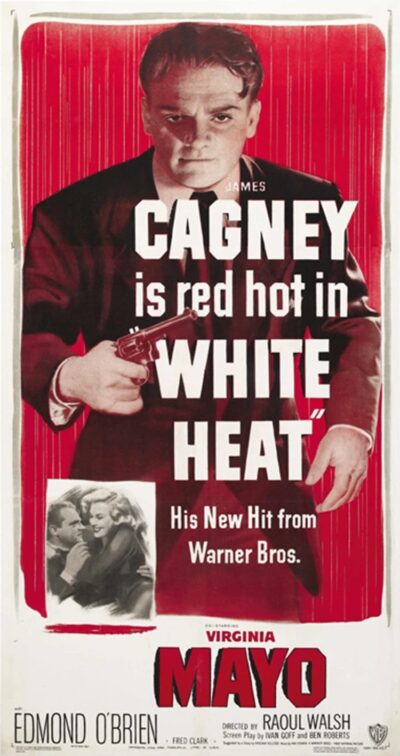[THE CHALK-OUTLINE]

White Heat (1949): Breakdown by The Hestinator (Brandon)
A psychopathic gangster who’s losing his grip on reality and obsessed with his mother grapples with threats against his life from both inside and outside gang, including an undercover copper.
[THE GOOD, THE BAD, AND THEIR BADASSITUDE]
THE BAD GUYS:

James Cagney as Cody Jarrett
This is a gangster flick, so we’re starting with the baddies this time.
After a string of financially unsuccessful movies, legendary actor James Cagney decided to return to the genre that served him best: the crime film. He played mobsters and other crooks throughout the 1930s, and now he was making his explosive return to that style in a motion picture that would try to be the gangster-movie-to-end-all-gangster-movies. Cagney’s character here, Cody Jarrett, is not just ruthless, he’s borderline-insane. Debilitated by searing migraines and wanting to do the wango tango with his own mother, this is not exactly the James Cagney that fans saw in The Public Enemy (1931) (although that’s still a masterwork in its own right). Quick with a quip, Jarrett murders without remorse and only cares for one person on this planet: you guessed it, Ma Jarrett. Cody Jarrett’s gang of thieves and cutthroats may not be entirely loyal to the head honcho, with ambitious gunman “Big Ed” Somers (Steve Cochran) having his own plans for who should lead this wild bunch.
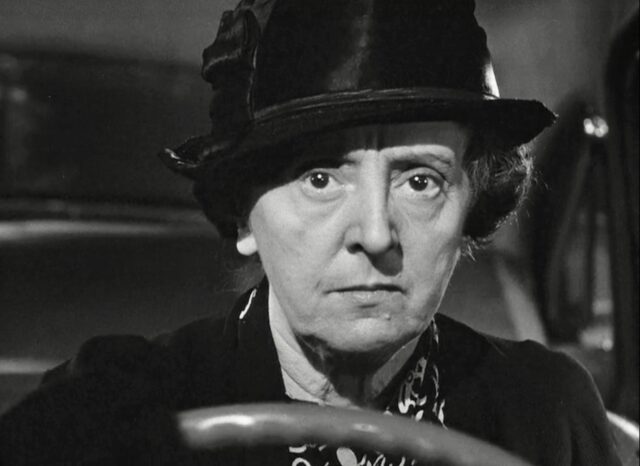
Margaret Wycherly as Ma Jarrett
Wait…what?! A character played by Margaret Wycherly is in the villains’ section? She played Gary Cooper’s dear, old mother in Sergeant York (1941)! Playing against type, Wycherly gets a chance to show her versatility as Cody Jarrett’s scheming mama. Probably based off the FBI’s explanation of Ma Barker, this woman comforts Cody in his moments of agony and may be the real power behind the throne. Wycherly’s performance is subdued and lets Cagney run away with his bombastic theatrics.

Virginia Mayo as Verna Jarrett
Verna is Cody’s current wife and a former hooker (something that’s implied awfully strongly for a Production Code-era Hollywood movie). She’s a gold-digger with little love for her significant other, preferring to sneak a kiss or two (and probably more if the Code wasn’t in effect) with “Big Ed,” Cody’s rival inside the gang. Can you really blame her for not wanting to be married to a mommy’s boy brute like Jarrett, and trying to get it on with the guy whose nickname is “Big?”
THE GOOD GUY:

Edmond O’Brien as Hank Fallon (codename: “Vic Pardo”)
Hank is an undercover federal agent who’s been tasked with infiltrating the Jarrett Gang and figuring out who the mob leader’s handler is. He spends most of his time in prison trying to befriend scumbags or fishing (this dude knows his fish, I’m telling ya). Now, he must become the new maternal figure in Cody Jarrett’s life to win his trust. Honestly, there’s not a whole lot to this character, as he takes a backseat to James Cagney’s insanity and, due to the Production Code, must show as much respect and dignity to the job as possible.
Being a product of its time, the authority figures in White Heat are all perfect role models who display perfect competence. I wouldn’t describe them as “humorless” exactly, but, perhaps due to the Code, they can seem a little vanilla by today’s standards. When Hank Fallon tosses out a remark about perceiving Illinois law enforcement as inept, his superior Philip Evans (John Archer) politely explains to him that they’re not screwing up, and that the lawmen over in the Land of Lincoln are, in fact, collaborating with his office and that they’re on top of things.
[THE SEX AND VIOLENCE]
DUDESWEAT AND MACHISMO:
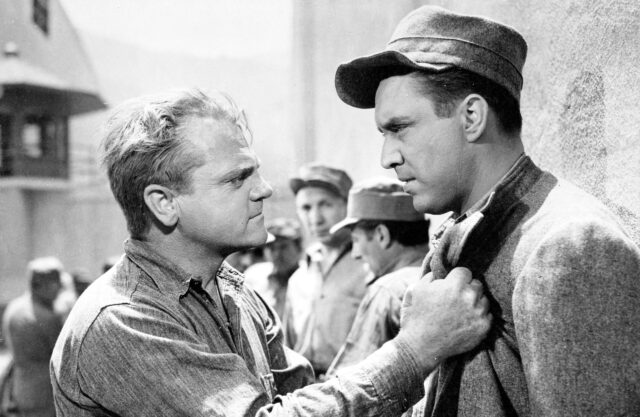
This is an American film from 1949, so don’t expect much in the way of horny behavior, but Cody Jarrett does seem to have the hots for Hank Fallon (under the alias “Vic Pardo”) after he joins the gang. When Fallon tries to sneak off one blustery night, Cody stops him and seems a little disappointed that Hank doesn’t want to have a threesome with him and his dead Ma in the moonlight. Later, ol’ Vic Pardo breaks Cody’s fragile heart by revealing himself to be an undercover copper, prompting Jarrett’s total mental meltdown.
EXPLOITATION AND MISOGYNY:
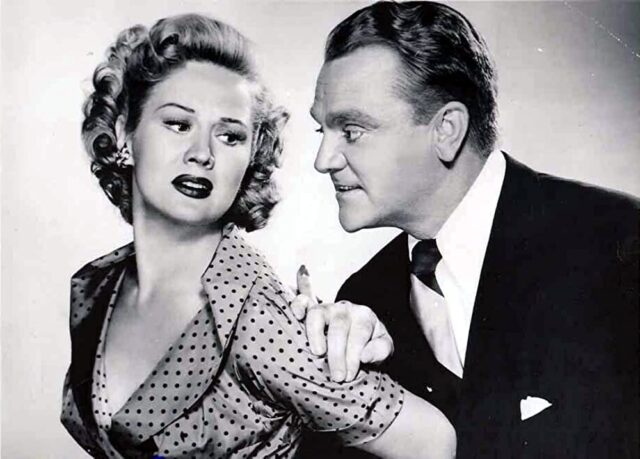
As mentioned above, Cody’s wife Verna was a former lady of the night, and Jarrett treats her rough. No, he doesn’t slam any food in her face, but he does kick her off her chair once after she makes a crack about his mother buying strawberries for him. An old lady apparently gets shot in the back (well offscreen) and another female gets locked up in prison.
MURDER BY NUMBERS: [ 15 ]

For being an old, black-and-white crime flick, White Heat has a very respectable body count. Fifteen people end up biting the dust, with only one (Zuckie Hommell [Ford Rainey], who gets blasted by boiling-hot steam from a train and then is left to die in a freezing-cold house) whose actual act of dying is offscreen (his body is in the morgue, though, so it counts towards the tally). Other than Zuckie’s demise and another character who gets blown up at an exploding chemical factory, all the deaths are from gunfire. The opening train heist is reported to have four fatalities, but only three corpses are shown onscreen. The carnage is pretty tame by today’s standards, but blood shows up in tiny quantities once or twice.
Of all the characters, it’s not much of a surprise that James Cagney’s Cody Jarrett racks up the highest kill count. He butchers a whopping nine people in White Heat (including – well – I won’t go into spoilers on that final kill here), which is a pretty high number for a person in a mob movie.
MOST SATISFYING ASS-KICKING AND/OR DEATH:
As far as non-fatal beatdowns in White Heat go, the best is clearly the little martial artsy fight Hank Fallon gets into with one of Cody’s sentries when he tries to sneak off in the middle of the night. Don’t expect Jackie Chan-level madness, but actor Edmond O’Brien gets a chance to show off some sick moves as he beats the tar out of the hapless guard. He probably would’ve strangled the bastard if Cody Jarrett hadn’t walked in on the melee.
For best death scene, things get a little trickier. It’s hard to argue with Cody shooting airholes in his car to help Roy Parker (Paul Guilfoyle) breathe easier, but the show-stopping demise of Cody Jarrett has got to be the champion. Trapped by the police atop a giant-ass storage tank of flammable gas, Jarrett loses his shit and decides to blow himself up and meet his beloved ma in Hell rather than surrender to the coppers. It’s just about as good an exit as an actor could wish for.

“MADE IT, MA! TOP OF THE WORLD!”
[THE BEST OF THE REST]
EPIC MOMENT:
Cody’s Concern for Roy Parker
In a moment I touched on earlier, Cody Jarrett busts out of prison, with weaselly butt-monkey Roy Parker trapped in his car trunk. While Jarrett’s casually eating some chicken (as one does), Parker starts bitching about how he needs some fresh air. Out of the kindness of his heart, Cody whips out his forty-five and starts popping airholes in the trunk to help Roy (as one does). It’s a touching scene, showing off Cagney’s character’s more tender side.
BEST LINE:
There’s plenty of good bits of dialogue here, but I think we both know which line I’m going to choose. Okay, let’s both say it at the count of three…
One…
Two…
Three…
Michael “Reader” Curtin (G. Pat Collins): “Jerry, you couldn’t get me out of here if I was pardoned.”
Wait…no! That’s some great writing and all, but I’m talking about the other big line from White Heat:
“MADE IT, MA! TOP OF THE WORLD!”
[THE EXECUTION]
White Heat is old, there’s no denying that. It’s black-and-white and it’s not even really an action movie. (Although it is definitely action-adjacent.) Despite this, this film still holds up as one of the essential entries into the canon of Badass Cinema. We’re talking a ten-outta-ten motion picture here. While many crime flicks of the time period may come across as a little turgid nowadays, this rollercoaster ride is still very viable entertainment. While different gangster movies, like The Godfather (1972), for example, can across as stately (to a fault even), watching White Heat feels like juggling lit sticks of dynamite.
How does this production still hold up as a masterpiece? A lot of it has to do with James Cagney’s central performance. He may have won the Best Actor Oscar for dancing around the silver screen as George M. Cohan in Yankee Doodle Dandy (1942), but playing tough guys was what Cagney was born to do. When I think of the greatest performances in cinema history, Cagney’s tour-de-force turn as Jarrett is one of the very first to spring to mind. You just can’t take your eyes off this guy.
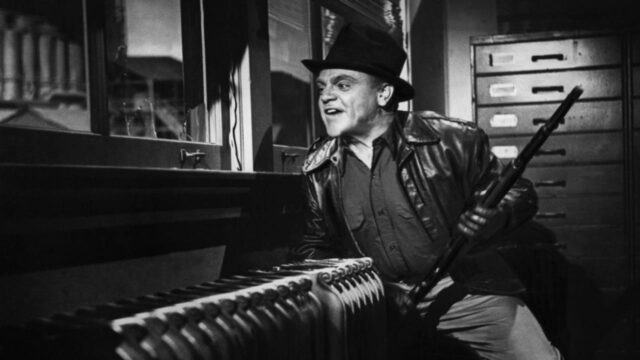
White Heat is a lean, mean killing machine. It may be nearly two hours long, but it feels perfectly constructed. This flick should be shown in film schools to illustrate how to make a taut picture. Fearsome, feisty, fast-paced, and tight, you couldn’t really delete a single scene without having to rewrite the entire screenplay. This is in stark contrast to Cagney’s next gangster movie, Kiss Tomorrow Goodbye (1950), which features a ludicrously out-of-place romantic subplot that adds nothing to the finished product. Yes, that movie is brutal and nasty when it wants to be, but its script could’ve used a rewrite or two. The pulpy, tough-talking dialogue in White Heat is another delight, with nary a line being wasted.
If one goes into this work expecting intricately choreographed action scenes on par with those found in, say, Police Story (1985), they will walk away sorely disappointed. This is not that kind of movie. There are several good action beats here and there (especially at the beginning and end), but the physical stuff here feels pretty reined-in and semi-realistic compared to modern actionpaloozas. Still, White Heat must’ve been quite the face-melter back in 1949, packed with much more excitement than your typical movie from the time period.
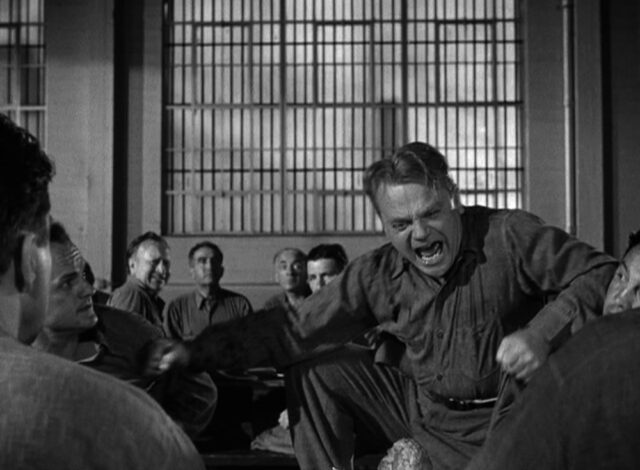
Combining elements of the gangster film, the heist picture, the undercover cop saga, the psychological thriller, the prison flick, and the film noir, this movie goes all-out to entertain the audience. To be honest, I wouldn’t really consider it a full-blown noir (despite having ingredients of it, like the femme fatale and the shadowy cinematography); it just feels like a 1930s-style gangster picture on steroids too much of the time. Let’s call it “noir-adjacent” too.
White Heat has not gone unnoticed by popular culture, with lines of its dialogue being sampled in the songs “White Heat” by Madonna and “Crazy” by 50 Cent. Also, the ending of the music video for the power ballad parody “Don’t Download This Song” by “Weird Al” Yankovic appears to spoof the finale of the mob movie in question, with a kid being immolated on top of a Horton sphere. Footage from the flick was incorporated into the noir farce Dead Men Don’t Wear Plaid (1982) starring Steve Martin.

The musical score from Max Steiner’s pretty good. No, it doesn’t rank up there with the best of his work, but – hey – we’re talking about the guy who did the musical scores for Casablanca (1942), Gone with the Wind (1939), King Kong (1933), Adventures of Don Juan (1948), The Most Dangerous Game (1932), and The Treasure of the Sierra Madre (1948). Not every one of his scores is going to be a knock-out winner, though this one has its moments.
This flick is simply one of the greats. Between James Cagney’s towering performance and the sharp, snappy script, you aren’t going to find very many crime films better than this one. Some of the action may be a little clunky to modern eyes, but the movie’s got it where it counts. To use a stupid pun that your typical film critic has probably already used for the flick, it’s at the top of the world. Oof, that was painful to say.
[THE MORAL OF THE STORY]
Don’t try to take James Cagney alive.
[THE AOBG ACTION CHECKLIST]
[X] Athlete(s) Turned “Actor”*
[ ] Clinging To The Outside Of A Moving Vehicle
[ ] Crotch Attack
[ ] Dialogue Telling Us How Bad-Ass The Main Character(s) Is/Are
[ ] Ending Featuring An Ambulance, A Blanket, Or A Towel
[X] Factory/Warehouse/Castle
[X] Giant Explosion(s)
[ ] Heavy Artillery
[ ] Improvised Weapon(s)
[X] Macho Mode(s) Of Transportation
[ ] Main Character Sports Facial Accessory(s)
[ ] Manly Embrace(s)
[ ] Notorious Stunt-Man Sighting
[ ] Passage(s) Of Time Via Montage
[ ] Politically Fueled Plot Point(s)
[X] Senseless Destruction Of Property
[X] Shoot-Out(s) and/or Sword Fight(s)
[ ] Slow-Motion Finishing Move(s)/Death(s)
[ ] Stupid Authoritative Figures
[ ] Substance Usage and/or Abuse
[ ] Tis the Season
[ ] Torture Sequence(s)
[ ] Unnecessary Sequel
[X] Vehicle Chase(s)
[ ] Vigilante Justice
*Wikipedia currently claims that Jim Thorpe plays a prison inmate in the big mess hall scene.
[TOTAL: 7 outta 25]

